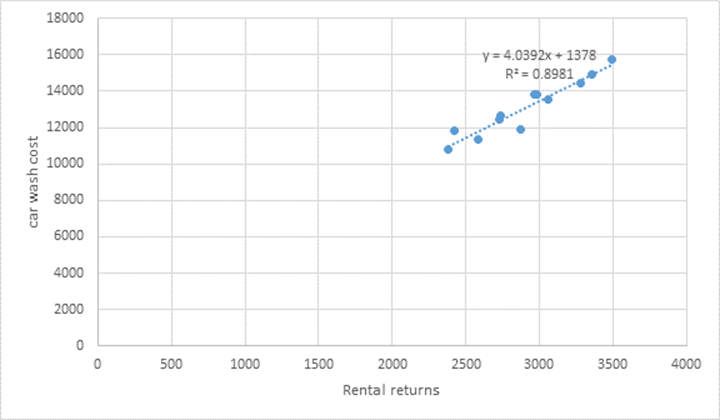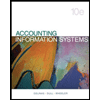
Concept explainers
1.
Introduction:
Variable costs and Fixed costs:
Variable costs are those that increase or decrease with the general volume of work. Some of the examples of variable costs are sales commissions, labor costs, raw material costs, etc. Fixed costs are those costs that remain fixed irrespective of the volume of work. Some of the examples of fixed costs are office rent, administrative expenses,
Least square regression method:
The least-square regression method uses the regression line to classify the total cost into variable and fixed cost and thus minimizing the sum of squares of the errors and hence we can get the best line of fit with minimum variances. The least-square regression can be expressed as Y = a + bx
Where Y is Total cost
A is the total fixed cost
B is the variable cost
X is the activity level
To prepare: a scatter plot graph.
1.
Answer to Problem 2A.2E
This is the scatterplot graph for the B rental car.

Explanation of Solution
According to the given information the rental returns and car wash costs of B rental cars have been given and we have to prepare a scatter graph plot where the car wash cost should be on the vertical axis and the rental returns on the horizontal axis. To prepare the scatter graph first we have to go to insert option and select scatter graph from charts. The next step is to enter the X values and Y values and then we will get the graph. Now we can add trend line and axis title by clicking on the + symbol next to the graph. After adding the trend line we can click on the arrow button next to the trend line and select more options and then in that we have to checkmark display equation and display R squared value on the chart. The following is the data for plotting the graph:
| Rental returns | Car wash costs ($) |
| 2380 | 10825 |
| 2421 | 11865 |
| 2586 | 11332 |
| 2725 | 12422 |
| 2968 | 13850 |
| 3281 | 14419 |
| 3353 | 14935 |
| 3489 | 15738 |
| 3057 | 13563 |
| 2876 | 11889 |
| 2735 | 12683 |
| 2983 | 13796 |
2.
Introduction:
Variable costs are those that increase or decrease with the general volume of work. Some of the examples of variable costs are sales commissions, labor costs, raw material costs, etc. Fixed costs are those costs that remain fixed irrespective of the volume of work. Some of the examples of fixed costs are office rent, administrative expenses, depreciation, etc.
Least square regression method:
The least-square regression method uses the regression line to classify the total cost into variable and fixed cost and thus minimizing the sum of squares of the errors and hence we can get the best line of fit with minimum variances. The least-square regression can be expressed as Y = a + bx
Where Y is Total cost
A is the total fixed cost
B is the variable cost
X is the activity level
To calculate: the variable cost per rental return and the monthly fixed washing cars using least square regression method.
2.
Answer to Problem 2A.2E
Thus, the variable cost per unit is $4.04 and the fixed cost per unit is $145583 for Bargain rental car.
Explanation of Solution
To calculate the variable cost per rental return and the monthly fixed washing cars using the least square regression method first we have to calculate the X, Y, X2 and XY. In the given data the rental return is taken as X and car wash costs is taken as Y, let us now calculate the X2 and XY:
| Months | X | Y | X2 | XY |
| January | 2380 | 10825 | 5664400 | 25763500 |
| February | 2421 | 11865 | 5861241 | 28725165 |
| March | 2586 | 11332 | 6687396 | 29304552 |
| April | 2725 | 12422 | 7425625 | 33849950 |
| May | 2968 | 13850 | 8809024 | 41106800 |
| June | 3281 | 14419 | 10764961 | 47308739 |
| July | 3353 | 14935 | 11242609 | 50077055 |
| August | 3489 | 15738 | 12173121 | 54909882 |
| September | 3057 | 13563 | 9345249 | 41462091 |
| October | 2876 | 11889 | 8271376 | 34192764 |
| November | 2735 | 12683 | 7480225 | 34688005 |
| December | 2983 | 13796 | 8898289 | 41153468 |
| Total | 34854 | 157317 | 102623516 | 462541971 |
Now let us calculate the variable cost using following formula:
Variable cost per unit
Now, let us calculate the fixed cost per unit using following formula:
Fixed cost per unit
Want to see more full solutions like this?
Chapter 2A Solutions
MGMR ACCT F/MANAGERS-CONNECT 180-DAY COD
- Below is information for Blue Company. Using this information, answer the following questions on the "Calculation" tab in the file. Show your work (how you got your answer) and format appropriately. Blue company has prepared the following contribution format income statement based on a sales volume of 1,000 units (the relevant range of production is 500 to 1,500 units): Sales $ 40,000 Variable expenses 24,000 Contribution margin 16,000 NOTE: Use the amounts in the original fact pattern to the left as your basis for the questions below. Fixed expenses 12,000 Net operating income $ 4,000 Questions: 1. What is the contribution margin per unit? 2. What is the contribution margin ratio? 3. What is…arrow_forwardI am looking for help with this financial accounting question using proper accounting standards.arrow_forwardGeneral accountingarrow_forward
- Please explain the correct approach for solving this general accounting question.arrow_forwardRobin Corporation has ordinary income from operations of $30,000, net long-term capital gain of $10,000, and net short-term capital loss of $15,000. What is the taxable income for 2010? a) $25,000. b) $27,000. c) $28,500. d) $30,000. e) None of the above.arrow_forwardPlease explain the solution to this financial accounting problem using the correct financial principles.arrow_forward
- I need the correct answer to this financial accounting problem using the standard accounting approach.arrow_forwardI am trying to find the accurate solution to this general accounting problem with the correct explanation.arrow_forwardI need help with this financial accounting question using the proper financial approach.arrow_forward
 Pkg Acc Infor Systems MS VISIO CDFinanceISBN:9781133935940Author:Ulric J. GelinasPublisher:CENGAGE L
Pkg Acc Infor Systems MS VISIO CDFinanceISBN:9781133935940Author:Ulric J. GelinasPublisher:CENGAGE L Managerial Accounting: The Cornerstone of Busines...AccountingISBN:9781337115773Author:Maryanne M. Mowen, Don R. Hansen, Dan L. HeitgerPublisher:Cengage Learning
Managerial Accounting: The Cornerstone of Busines...AccountingISBN:9781337115773Author:Maryanne M. Mowen, Don R. Hansen, Dan L. HeitgerPublisher:Cengage Learning Cornerstones of Cost Management (Cornerstones Ser...AccountingISBN:9781305970663Author:Don R. Hansen, Maryanne M. MowenPublisher:Cengage Learning
Cornerstones of Cost Management (Cornerstones Ser...AccountingISBN:9781305970663Author:Don R. Hansen, Maryanne M. MowenPublisher:Cengage Learning


